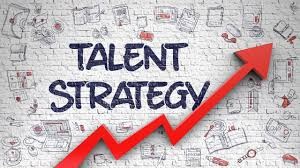Invest in a New Talent Strategy for Greater Productivity

Every business executive would love to find a new way for his organization to gain productivity and unlock new growth possibilities. The $25,000 question is how to do it.
Prior to the information age, the focus was on investing in industrial machines, and that certainly paid off in many ways. As business practices evolve, however, companies are paying more attention to using digital technology. This necessitates strategic shifts in other areas of the business as well.
In the midst of the COVID-19 pandemic, many companies accelerated their path to digitization and automation by as much as 20 to 25 times faster than they previously thought possible, and they plan to continue their investments in this area, according to recent McKinsey research.
In a December 2020 survey of executives, McKinsey found that roughly 75 percent of respondents in North America and Europe expected their investment in new technologies to accelerate in the next few years. This represents a leap from the 55 percent of respondents who said they increased such investment between 2014 and 2019.
These are positive indicators for growth potential ahead. That said, low-skilled workers risk being displaced by automation, and organizations may find even more inequality between high- and low-skilled workers. This trend suggests a need for significant retraining programs and a need for a stronger knowledge infrastructure to encourage greater productivity.
Focus on the Intangible
With global competition so fierce, the focus for growth needs a new target. New research is showing that the organizations reaping the most growth in their sectors are now strategically focusing on their intangible assets, such as intellectual property (IP), research, technology, software and employees’ skills and knowledge — in other words, areas that are not physical or financial assets.
In the past 25 years, the US and 10 European countries combined have experienced 63 percent growth in gross value added (GVA), a measure of economic growth, so clearly businesses in these regions are getting the message about how important it is to keep looking at new ways to grow and do things better. This was a major finding of a new survey shared by McKinsey of more than 860 executives from 21 sectors that was conducted in March 2021 in 16 countries.
Key to the findings is that investment in intangible assets grew 29 percent. Data from INTAN-Invest leveraged by McKinsey shows these investments promote overall business growth by as much as 28 percent more than other sectors. Interestingly, growth in intangibles investment had slowed for a while after the global financial crisis of 2018 and productivity growth had slowed as well, whereas the most recent investments in intangibles have aided total productivity, suggesting a link.
Further strengthening the argument, the companies with the most growth appear to be investing 2.6 times more in intangibles than sectors with the lowest-GVA growth.
Consider the findings from firms dealing with financial services, where the competitive advantage is rooted in knowledge. Based on research five years ago, McKinsey had estimated that 43 percent of all working hours in banking activities will be automated in the future. Obviously, this will require a huge shift in the type of skills needed, from basic cognitive skills to technological ones. The need to invest more in human and relational capital is going to be essential.
Talent Development in the Digital Age
As companies increasingly focus on digital transformation in their infrastructures, increased education and communications technology need to be employed.
The top-growth companies understand that data and analytics are a necessity to thrive competitively so they can make data-driven decisions, but they also know that investment in talent is crucial for innovation. Accordingly, the executives responding to McKinsey’s survey reported that they embed a combination of data, talent, innovation and purpose in their day-to-day operations.
Investment in Talent Fuels Productivity
Having a strategy and an environment that promotes attraction of talent needed to sustain critical capabilities provides a clear road map with a clear purpose and mission statement. It comes down to adopting a risk-taking approach that involves continuously learning from experiences and reexamining strategies to see what ultimately works in achieving competitiveness and growth.
In particular, it’s important to have a talent strategy focused on building employees’ critical digital and thinking capabilities, social-emotional learning, and adaptability and resilience. It’s not just about the individual, however; organizations also should focus on creating an environment that fosters collaboration and helps build relationships among workers at all levels. This can help yield new products, processes and capabilities for better competitive strength.
Creating this new talent strategy often means approaching employees in a different way. Firms that are effectively making the jump are leveraging agile methodologies for team organization, and productivity methodologies such as David Allen’s Get Things Done (GTD) paradigm for better efficiency. Training employees on GTD and managing them with methodologies such as agile creates the foundation for the needed capabilities mentioned above.
Where Growth Comes From Today
Companies operating in knowledge-intensive sectors, such as financial services, tend to invest 5.4 times more than similar companies with the lowest growth rates, McKinsey found.
One top European bank had been struggling with limited access to data, a skills shortage and conflicting data strategies. It decided to re-evaluate its growth strategy and ended up increasing data access and deployed an analytics transformation program. This helped tackle the firm’s organizational and managerial issues by giving the firm a stronger structure in which to redesign the organization, develop a talent strategy and modernize its data architecture. All of this, in turn, helped the organization to build stronger analytics capabilities. Ultimately, these investments resulted in stronger decision-making, streamlined reporting and immediate access to data.
Meanwhile, Walmart approached business challenges a bit differently due to different needs. Whereas the retail giant formerly relied on opening new stores, optimizing shelf layouts and expanding warehouses, it decided in 2019 to focus more on building an innovation culture. As part of this, it looked at reskilling the existing workforce and attracting new talent.
This kind of focus is backed by evidence. Top growers not only attract but also retain talent by offering an unrivaled environment and a unique value proposition. In fact, McKinsey’s research shows that top growers are twice as likely to have defined performance measures for all parts of the organization and also are 1.7 times more likely to have talent-management processes that foster diversity. The latter has been a major focus, albeit a slow-growing one, of many companies as a growth enabler.
Training and Development = Productivity
Many companies can attribute a major part of their growth to investing in intangible assets that involve knowledge and learning. The top growers do acknowledge that it’s important to scale any disruptive business models.
Those who effectively deploy programs aimed at reskilling workers, promoting training and development, and diversifying their workforces, are definitely growing more than other competitors, based on McKinsey’s research.
Getting ahead in these areas will require constant oversight, and it requires a certain shift in thinking because it likely will involve a more “test-and-learn” risk-taking culture.
The payoff from investing in a stronger knowledge base and related innovation could be huge.
Swadeck Taher OSK is a Chartered Accountant (ICAEW) and a Chartered Marketer (CIM) running businesses and coaching, consulting, mentoring CEOs and entrepreneurs ranging from startups through family businesses to established top 100 companies in Mauritius. He enjoys sharing the expertise he developed over the last thirty years at senior leadership/directorship level with his clients, business partners and other budding entrepreneurs.
Swadeck is also a GTD Practitioner and a Certified GTD Trainer. He helps others experience what the Productive Experience feels like and how they too can savour stress free productivity.
Sakeenah Co Ltd is the only Certified International Partner of the David Allen Company in Mauritius.
GTD® and Getting Things Done® are registered trademarks of the David Allen Company.
Disclaimer: All images are copyright to their respective owners. If any of the images used in this article belongs to you and you wish these removed, please send me a message and I shall oblige.
Join Our Mailing List
For receiving our news and updates in your inbox directly.


